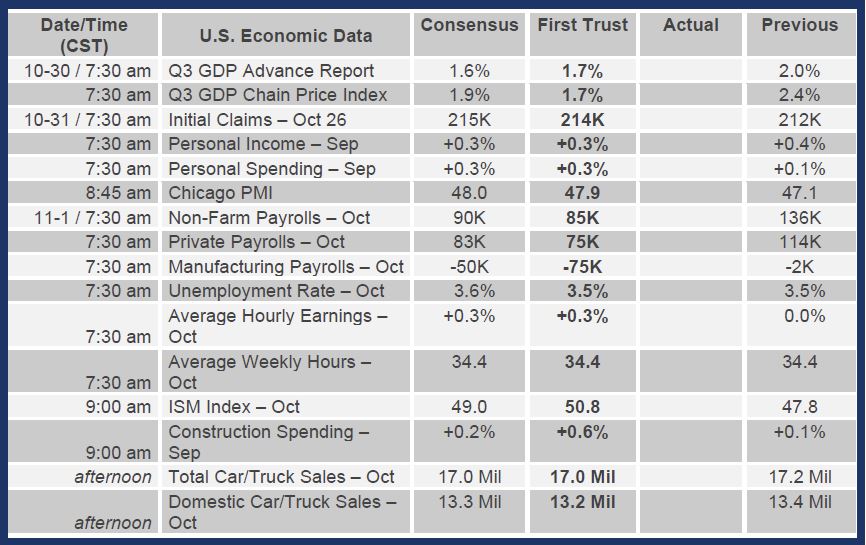Brian Wesbury Weekly Outlook
29.10.2019 17:38 - First Trust Global Portfolios Limited

Another Fed Rate Cut on the Way
At the close of business on Friday, the futures market in federal funds was putting the odds of a 25 basis point rate cut on Wednesday at 90%, which would place the federal funds rate in a range between 1.50 and 1.75%, the lowest it’s been since mid-2018. We hate to agree with the conventional wisdom, but in this case, we think it’s right. It’s very unlikely the Fed would let expectations of a rate cut get so high (and so soon) before a meeting, unless it was poised to fulfill those expectations.
In our opinion, this rate cut is completely unnecessary. The unemployment rate is 3.5%, much lower than the 4.2% that Fed policymakers think it will average over the long run. Nominal GDP – real GDP growth plus inflation – is up 5.0% annualized in the past two years, well above the level of short-term rates. The M2 measure of the money supply is up 6.5% from a year ago, a healthy acceleration from the 3.4% increase the year before.
As we argued back in July, the Fed has abandoned data dependence. Instead, it looks like the Fed is running monetary policy based on fears about trade negotiations, Brexit, and turbulence in the financial system, rather than actual hard economic data.
Lately the Fed has re-started the use of repos, forced by a combination of (their own) overly tight banking rules, large Treasury auctions (due to big federal deficits), and the inverted yield curve, which create periodic issues for banks seeking overnight funds.
The Fed could address these issues in three ways. First, it could loosen bank rules, some of which are designed for crisis situations, and reports from a couple of weeks ago suggest bank supervisors are giving banks more flexibility to use Treasury securities instead of reserves, which should help in that regard. Second, the Fed could let banks pay higher borrowing costs and let natural market forces make banks adjust naturally. Or third, the Fed could permanently add reserves to the system which would mean it simply doesn’t want eased regulations or free markets to work.
The last path, which we think is unneeded, is what the Fed announced a few weeks ago when it decided to start increasing the size of its balance sheet once again, all the while claiming it somehow isn’t quantitative easing. In our view, QE is increasing the size of the balance sheet to lift excess reserves, no matter what the Fed is buying, be it short or long-dated treasuries, furniture, mortgages, or stocks.
After the meeting this week, we think Fed Chief Jerome Powell will hint the Fed is done for the year, even though the issues he used to justify rate cuts are still in play. He has hinted at short-term rate stability before, but buckled to market pressures to cut rates further. This time we think the hint will stick. Unless trade negotiations go south quickly, we think this will be the end of the rate cutting cycle. In the meantime, stay bullish on equities and expect bond yields to move higher.
Brian S. Wesbury - Chief Economist
Robert Stein, CFA – Deputy Chief Economist
